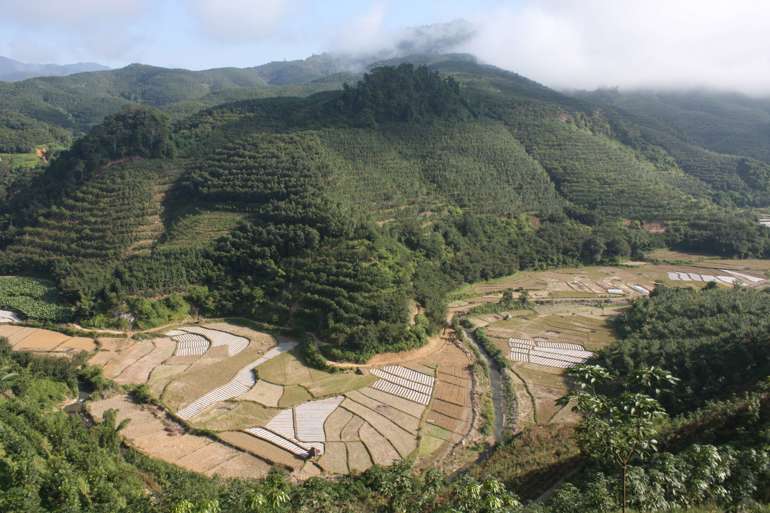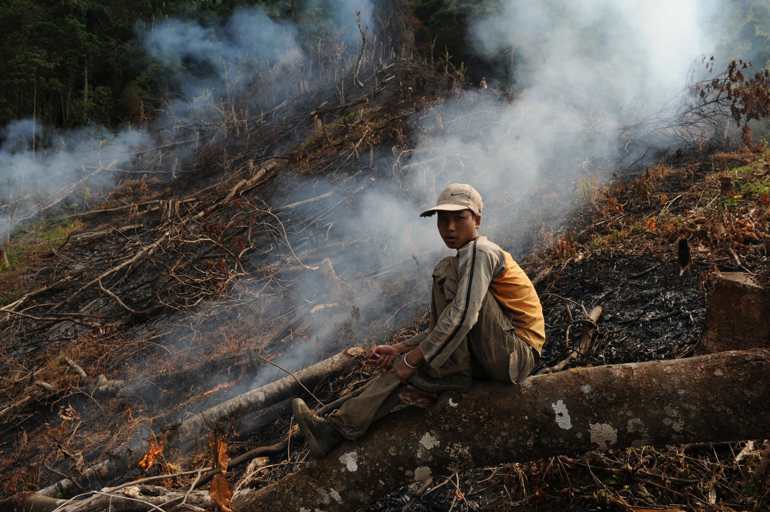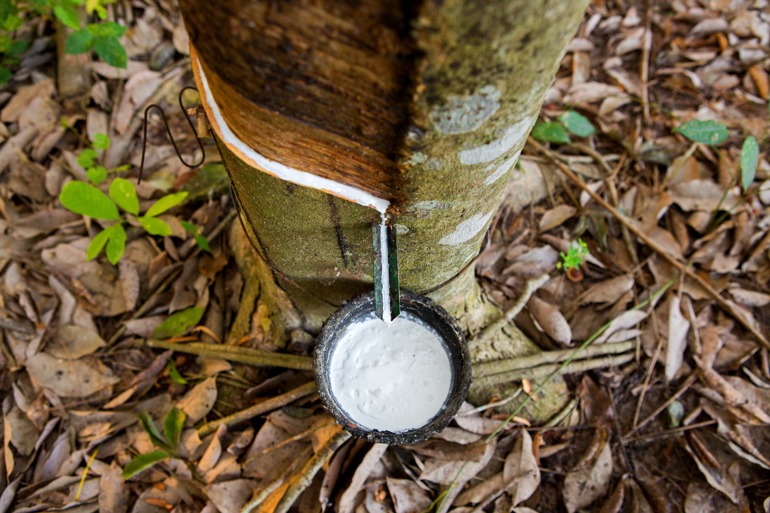Two groundbreaking studies by an international team, published in the renowned journals Nature and Conservation Letters, demonstrate that the impact of the global rubber trade on forests has been serially and substantially underestimated.
Using the latest satellite technology and cloud computing, and a review of more than 100 case studies, the fresh evidence reveals that rubber-driven forest loss is significantly larger than previously reported estimates, which have been widely used to inform policy. Now, scientists behind the research say equitable and sustainable solutions are needed without delay.
Led by the Royal Botanic Garden Edinburgh (RBGE), in collaboration with Kunming Institute of Botany (KIB), Chinese Academy of Sciences and CIFOR-ICRAF China Country Program, the satellite imagery-based paper in Nature shows that rubber-related deforestation could be three times greater than previously believed, and since the 1990s has impacted an area as large as Switzerland.

Image: Rubber plantations as far as the eye can see in Xishuangbanna, China © Dietrich Schmidt-Vogt, World Agroforestry Centre.
Dr Yunxia Wang, first author of the study, explained: “Rubber was already known to lead to forest loss, but quantifying the damage has been challenging. Because it is difficult to distinguish from natural forest on satellite imagery, it has received reduced attention when looking at the losses caused by commercial plantations. However, thanks to expanding earth observation and computing technology, there are increasing opportunities to map ‘difficult’ commodities. The results have been sobering.”
Underscoring the significance of this pioneering research, Professor Peter Hollingsworth, Deputy Keeper and Director of Science at RBGE commented: “The study highlights the importance of rigorous quantifications of the effects of cash crops on the environment. This is now increasingly possible thanks to advancements in earth observation technology.”
Senior author Dr Antje Ahrends noted: “While deforestation linked to rubber is widespread, some countries are of particular concern. In Cambodia, for example, over 40 per cent of rubber plantations are associated with deforestation. Our maps show that rubber plantations have encroached into areas of global importance for the protection of biodiversity, with over one million hectares planted in these areas. With 70 per cent of the world’s natural rubber yields destined for tyre manufacture, demand is not likely to diminish and the threat this poses to biodiversity should not be underestimated. In addition, while predominantly grown by smallholders with the potential to support livelihoods, rubber is also associated with land grabbing and human rights infringement in some countries.”

Image: Young rubber farmer © Jianchu Xu, Centre for Mountain Futures, Kunming Institute for Botany
A separate systematic review of case studies and analysis of recent trends in rubber area and yield, published in Conservation Letters and led by Bangor University, also indicated that rubber is regularly linked to deforestation. Warning that, as demand grows and yields stagnate, continued deforestation for rubber is to be expected, lead author Dr Eleanor Warren-Thomas commented: “Our analysis shows substantial expansion of rubber plantations has occurred in many producer countries since 2010, with particularly rapid increases in new locations such as Cote d’Ivoire. Some 2.7 million to 5.3 million hectares of additional harvested area could be needed to meet industry estimates of demand by 2030. It is critical that existing rubber producers are supported to improve their yields and maintain production, to avoid ongoing expansion of plantation area.”
Both studies emphasise that while it is critical to halt deforestation associated with rubber, it is vital that smallholders, who account for 85 per cent of natural rubber production, are not marginalised by regulations.
Dr Maria Wang, from the Grantham Centre for Sustainable Futures at the University of Sheffield and co-author of the study published in Conservation Letters, said: “Rubber smallholders and industry understandably fear extra burdens placed on them by regulations. However, these studies show that the biodiversity impacts and deforestation from rubber cannot be ignored and that there is a need for solutions that work for smallholders, without putting any more pressure on the planet.”
Dr Ahrends concluded: “While it is encouraging to see an increasing number of initiatives and policy changes that aim to halt commodity-driven forest loss, there is a risk of inflexible regulation marginalising the poor as only wealthy rubber producers and traders can afford to pay remote-sensing companies to verify that goods are deforestation-free.
“We are, therefore, working with smallholder initiatives and other key players in the sector, including the Forest Stewardship Council ®, ZSL, and the Global Platform for Sustainable Natural Rubber, to ensure that our rubber and deforestation maps are widely and easily accessible to all stakeholders, in particular to smaller economic players.”

Image: Rubber tapping © Global Platform for Sustainable Natural Rubber
Professor Jianchu Xu, Head of Centre for Mountain Futures at KIB and Principal Scientist from CIFOR-ICRAF China Program said: “As one of the largest rubber consumers, China is very concerned about displaced deforestation from international trade. With support from the China-UK Collaboration on International Forest Investment and Trade Program, we have developed the world’s Guidance for Sustainable Natural Rubber to support the implementation of the Kunming-Montreal Global Biodiversity Framework.”
Research partners with the Royal Botanic Garden Edinburgh and Bangor University on the two papers were Kunming Institute of Botany, China; Xishuangbanna Tropical Botanical Garden, China; Stockholm Environment Institute, University of York; University of Bern, Switzerland; Yunnan Academy of Social Sciences, China; International Institute for Applied Systems Analysis (IIASA), Austria; University of Sheffield.
Primary funders of the research were the UK Research and Innovation’s Trade, Development and Environment Hub to the UN Environment World Conservation Monitoring Centre and UK Research and Innovation NERC-IIASA Collaborative Research Fellowship.
Main image: Land conversion © Yin Lun, Centre for Biodiversity and Indigenous Knowledge.
ENDS
For further information, interviews or images, please contact Shauna Hay on +44 7824 529 028 or Suzie Huggins on +44 7385 491 460
EDITOR’S NOTES
While natural rubber is often considered a renewable resource because it is produced from the latex of a tropical tree (Hevea brasiliensis), as opposed to synthetic equivalents produced from fossil hydrocarbons, its planting practices often involve clearing forests, leading to serious biodiversity loss and net carbon emissions.
Debate here is now focussing on the degree of biodiversity loss resulting from the planting of rubber. Possible solutions are varied and multifaceted. As well as contributing to the legislative processes and modelling maps, Dr Antje Ahrends and her colleagues are:
Collaborating with the Forest Stewardship Council® in promoting credibly certified deforestation-free rubber with a verified ethical supply chain. While large tyre producers correctly claim that supply chains are very hard to map for a non-perishable product such as rubber, the work of FSC® demonstrates that the bottom-up chain of custody certification from farmer cooperatives up to major global companies can work. It is generally accepted that certification and a degree of third-party auditing is important, while also ensuring certification can be rolled out at scale and is something smallholders, processors and traders can navigate and afford. Watch online for more information.
Promoting wise land-use planning to minimise loss-loss scenarios, such as boom crops or other unregulated crops replacing forest, leading to biodiversity loss and land degradation for short term / unsustainable economic gains.
Supporting smallholder cooperatives and incentivising sustainable production as well as helping them to navigate incoming regulations - farmers now need to map their production areas and provide verification of no deforestation from 2020 onwards if they want to sell to EU operators. The maps from the paper in Nature can help and this is already being pioneered in collaboration with AGRIAC, who are supporting several thousand smallholders in Thailand.
The new collaborations come thanks to a multidisciplinary approach from the Royal Botanic Garden Edinburgh, Stockholm Environment Institute, Forest Stewardship Council, Global Platform for Sustainable Natural Rubber, ZSL and AGRIAC, funded by the UK Natural Environment Research Council
ZSL Founded in 1826, ZSL is an international conservation charity, driven by science, working to restore wildlife in the UK and around the world; by protecting critical species, restoring ecosystems, helping people and wildlife live together and inspiring support for nature. Through our leading conservation zoos, London and Whipsnade, we bring people closer to nature and use our expertise to protect wildlife today, while inspiring a lifelong love of animals in the conservationists of tomorrow.
Royal Botanic Garden Edinburgh (RBGE) is a leading international research organisation delivering knowledge, education and plant conservation action around the world. In Scotland its four Gardens at Edinburgh, Benmore, Logan and Dawyck attract a million visitors each year. It operates as a Non-Departmental Public Body established under the National Heritage (Scotland) Act 1985, principally funded by the Scottish Government. It is also a registered charity, managed by a Board of Trustees appointed by Ministers. Its mission is “To explore, conserve and explain the world of plants".

